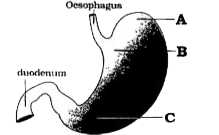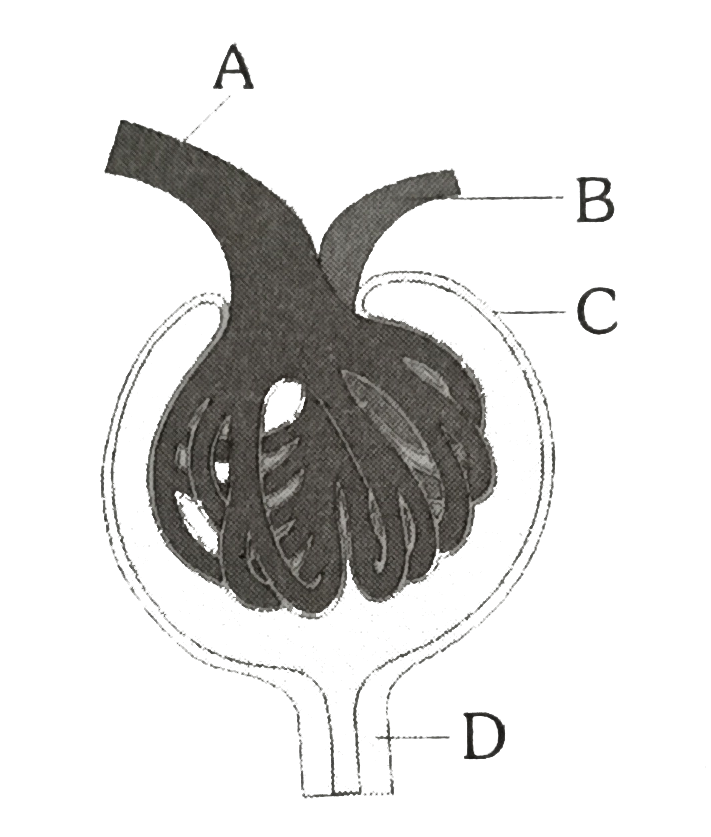The given diagram represent anatomical region of human stomach.Identify A, B and C

A
A-Fundus, B-Cardiac, C-Pyloric
B
A-Pyloric, B-Fundus, C-Cardiac
C
A-Cardiac,, B-Fundus,C-Pyloric
D
A-Fundus, B-Pyloric,C-Cardiac
Video Solution
Text Solution
The correct Answer is:B
(c) Animals which eat their own faeces are called pseudo ruminants or coprophagy. E.g., Rabbit, Guinea pig.
|
Topper's Solved these Questions
- CONSERVATION OF NATURAL RESOURCESBOOK - ERRORLESS CHAPTER - CONSERVATION OF NATURAL RESOURCESEXERCISE - Conservation Of Natural Resources
68 Videos
- ECOSYSTEM : STRUCTURE AND FUNCTION 1549BOOK - ERRORLESS CHAPTER - ECOSYSTEM : STRUCTURE AND FUNCTION 1549EXERCISE - Ecosystem : Structure And Function
275 Videos
Similar Questions
Knowledge Check

Anatomical regions of human stomach areAA- Fundus, B - Pyloric, C - CardiacBA -Cardiac, B - Fundus, C - PyloricCA - Fundus, B - Cardiac, C - PyloricDA-Pyloric, B - Fundus, C-CardiacThe given diagram represents stomatal apparatus in dicots and monocots. Identify A, B and C.
 AA-Epidermal cells, B - Subsidiary cells, C-Guard cellsBA-Guard cells, B - Subsidiary cells, C-Epidermal cellsCA-Guard cells, B - Epidermal cells, C-Subsidiary cellsDA-Subsidiary cells, B - Epidermal cells, C-Guard cells
AA-Epidermal cells, B - Subsidiary cells, C-Guard cellsBA-Guard cells, B - Subsidiary cells, C-Epidermal cellsCA-Guard cells, B - Epidermal cells, C-Subsidiary cellsDA-Subsidiary cells, B - Epidermal cells, C-Guard cellsThe below diagram represents the human digestive system. Identify A, B, C, D and E
 AA-Parotid gland, B-Liver, C-Pancreas, D - Caecum, E-Vermiform appendixBA-Parotid gland, B - Pancreas, C- Liver, D - Caecum, E-Vermiform appendixCA- Parotid gland, B - Caecum C-Pancreas, D-Liver, E-Vermiform appendixDA-Parotid gland, B - Liver, C- Caecum, D-Pancreas, E-Vermiform appendix
AA-Parotid gland, B-Liver, C-Pancreas, D - Caecum, E-Vermiform appendixBA-Parotid gland, B - Pancreas, C- Liver, D - Caecum, E-Vermiform appendixCA- Parotid gland, B - Caecum C-Pancreas, D-Liver, E-Vermiform appendixDA-Parotid gland, B - Liver, C- Caecum, D-Pancreas, E-Vermiform appendix
The diagram given below represents a section of small intestinal mucosa. Identify A,B and C

View SolutionThe given diagram represent the Malpighian body. Identify A to D

View SolutionThe given figure represents some stages in microgametogenesis identify A, B and C respectively

View SolutionIn the diagram identify A, B and C.

View SolutionThe following diagram represent the pathway of water movement in the root. Identify A, B, and C respectively

View Solution


